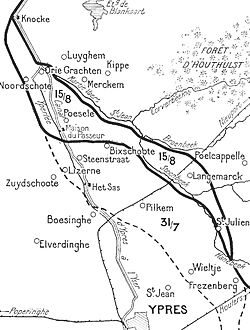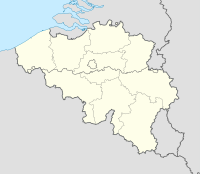| Battle of Langemarck | |||||||
|---|---|---|---|---|---|---|---|
| Part of the Third Battle of Ypres in the First World War | |||||||
 Front line after the Battle of Langemarck, 16–18 August 1917 | |||||||
| |||||||
| Belligerents | |||||||
|
|
| ||||||
| Commanders and leaders | |||||||
|
|
| ||||||
| Strength | |||||||
|
10 divisions 8 British, 2 French |
6 Stellungsdivisionen 5 Eingreifdivisionen | ||||||
| Casualties and losses | |||||||
| 16–28 August: 36,190 |
11–21 August: 24,000 16–18 August: 2,087 POW | ||||||
Langemark, a village in the Belgian province of West Flanders | |||||||
The Battle of Langemarck (16–18 August 1917) was the second Anglo-French general attack of the Third Battle of Ypres, during the First World War. The battle took place near Ypres in Belgian Flanders, on the Western Front against the German 4th Army. The French First Army had a big success on the northern flank from Bixschoote to Drie Grachten (Three Canals) and the British gained a substantial amount of ground northwards from St Julien to the boundary with the French.
The attack on the Gheluvelt Plateau on the right (southern) flank captured a considerable amount of ground but failed to reach its objectives. German counter-attacks recaptured most of the lost territory during the afternoon. The weather prevented much of the British programme of air co-operation with the infantry, which had made it easier for German reserves to assemble on the battlefield.
An unusually large amount of rain in August, poor drainage and lack of evaporation turned the ground into a morass, which was worse for the British and French, who occupied lower-lying ground and attacked areas which had been frequently and severely bombarded. Mud and flooded shell holes severely reduced the mobility of the infantry and poor visibility hampered artillery observers and the crews of artillery-observation aircraft. Rainstorms and the costly German defensive success during the rest of August, led the British to stop the offensive for three weeks.
In early September, the sun came out and with the return of a breeze, dried much of the ground. The British rebuilt roads and tracks to the front line, transferred more artillery and fresh divisions from the armies further south and revised further their tactics. The main offensive effort was shifted southwards and led to success on the Gheluvelt Plateau at the Battle of the Menin Road Ridge (20–35 September), the Battle of Polygon Wood (26 September – 3 October) and the Battle of Broodseinde (4 October), before the autumn rains began.
